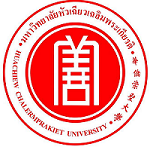Please use this identifier to cite or link to this item:
https://has.hcu.ac.th/jspui/handle/123456789/3550| Title: | การออกแบบตราสินค้าและเว็บไซต์อย่างมีส่วนร่วมเพื่อส่งเสริมผลิตภัณฑ์ชุมชน ตามแนวคิดเศรษฐกิจดิจิทัลอย่างยั่งยืน |
| Other Titles: | Participatory Brand and Website Design for Promoting Community Products According to the Sustainable Digital Economy Concept |
| Authors: | จรุงยศ อรัณยะนาค Jarungyod Arunyanak Huachiew Chalermprakiet University. Faculty of Communication Arts |
| Keywords: | ผลิตภัณฑ์ชุมชน Community products ชื่อตราผลิตภัณฑ์ -- การออกแบบ Brand name products -- Design เว็บไซต์ -- การออกแบบ Websites -- Design |
| Issue Date: | 2018 |
| Citation: | วารสารวิชาการศรีปทุม ชลบุรี 15, 1 (กรกฎาคม-กันยายน 2561) : 1-12 |
| Abstract: | งานวิจัยนี้เป็นการวิจัยเชิงปฏิบัติการอย่างมีส่วนร่วม (participatory action research: PAR) มีวัตถุประสงค์เพื่อศึกษาภูมิหลัง ออกแบบตราสินค้าและเว็บไซต์ให้กับผลิตภัณฑ์ชุมชน จํานวน 5 ผลิตภัณฑ์ รวมถึงการบูรณาการกระบวนการการเรียนการสอนด้วยกระบวนการวิจัย การบริการวิชาการเพื่อสังคม และการทํานุบํารุงศิลปวัฒนธรรม มีการประเมินคุณภาพและประสิทธิภาพ จากผู้มีส่วนร่วม 6 กลุ่ม คือ ผู้เชี่ยวชาญการออกแบบ นักวิชาการการออกแบบ นักศึกษา ผู้ประกอบการ ลูกค้า และพัฒนาชุมชนจังหวัดสมุทรปราการ สถิติที่ใช้ในการวิจัยคือ ค่าเฉลี่ย ส่วนเบี่ยงเบนมาตรฐาน และสถิติเปรียบเทียบ (paired t-test) พบว่า 1) ผู้ประกอบการมีความต้องการพัฒนาตราสินค้าและ เว็บไซต์เพื่อส่งเสริมผลิตภัณฑ์และโอกาสทางการค้า โดยจุดแข็ง จุดอ่อน โอกาส และอุปสรรคของ ผลิตภัณฑ์ คือ จุดแข็ง: มีคุณภาพดี ใช้วัตถุดิบท้องถิ่น จุดอ่อน: ไม่มีอัตลักษณ์ที่จดจําง่าย โอกาส: หน่วยงานรัฐสนับสนุน อุปสรรค: เศรษฐกิจตกตํ่า 2) ความพึงพอใจของผู้มีส่วนร่วมต่อการออกแบบ ตราสินค้าอยู่ในระดับมากที่สุด ส่วนเว็บไซต์อยู่ในระดับมาก และ 3) การบูรณาการการเรียนการสอน ด้วยกระบวนการวิจัย การบริการวิชาการเพื่อสังคม และการทํานุบํารุงศิลปวัฒนธรรม ทําให้นักศึกษา มีการเปลี่ยนแปลงหลังการเรียนรู้เพิ่มขึ้นอย่างชัดเจน ทั้งความรู้ด้านการวิจัย การเรียนการสอน การบริการวิชาการแก่สังคม และการทํานุบํารุงศิลปวัฒนธรรม This research is a participatory action research (PAR) and aims to study the background, brand and website design for of five products in a community which integrated with teaching methodology along with research process, academic services, art and culture conservation. There are quality and effectiveness evaluations by participants in six different sectors which are professional designers, academic designers, students, entrepreneurs, customers and the Provincial Community Development Office of Samutprakarn. The statistics used in the data analysis were mean, standard deviation, and paried t-test. The results indicated that: 1) entrepreneurs required to develop brands and websites for promoting products and trade opportunities. There were strengths and weaknesses, opportunities and threats associated with the products. The strengths were good quality and using raw materials from local. The weaknesses were related to the lack of the brand signatures, support and opportunity from the government as well as a recession, 2) Participants’ brand satisfaction was significance. Website design was at a high level, and 3) The integration of teaching methodology along with research process, academic services, art and culture conservation significantly facilitated the students in increasing their knowledge in these respective areas. Keywords: brand, website, community products, participatory design, digital economy |
| Description: | สามารถเข้าถึงบทความฉบับเต็ม (Full Text) ได้ที่ : https://www.chonburi.spu.ac.th/journal/booksearch/upload/1766-Jarungyod%201.pdf |
| URI: | https://has.hcu.ac.th/jspui/handle/123456789/3550 |
| Appears in Collections: | Communication Arts - Articles Journals |
Files in This Item:
| File | Description | Size | Format | |
|---|---|---|---|---|
| Participatory-Brand-and-Website-Design-for-Promoting-Community-Products.pdf | 90.13 kB | Adobe PDF | View/Open |
Items in DSpace are protected by copyright, with all rights reserved, unless otherwise indicated.
